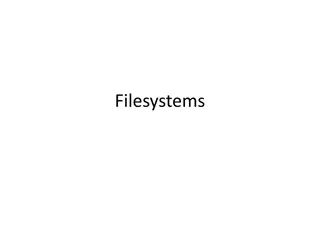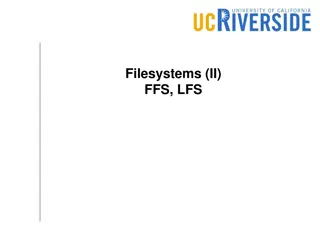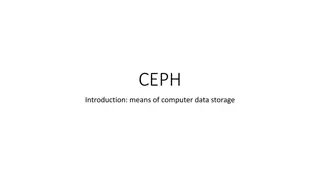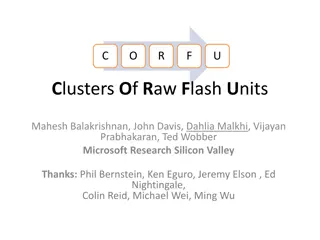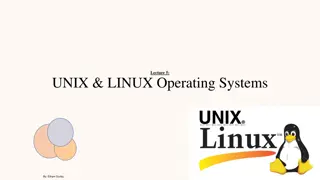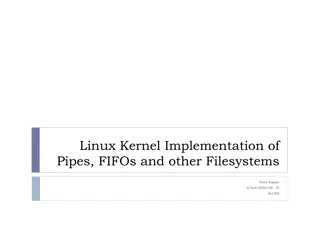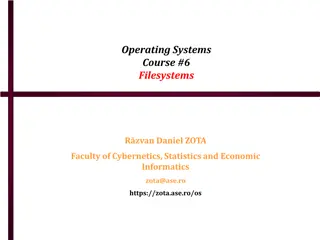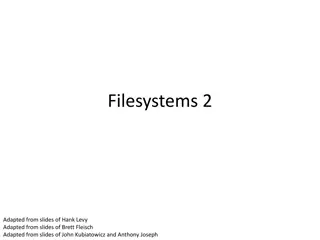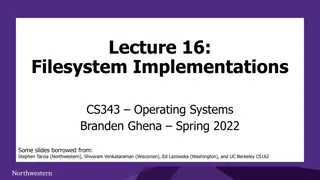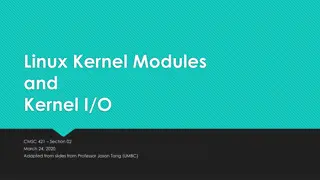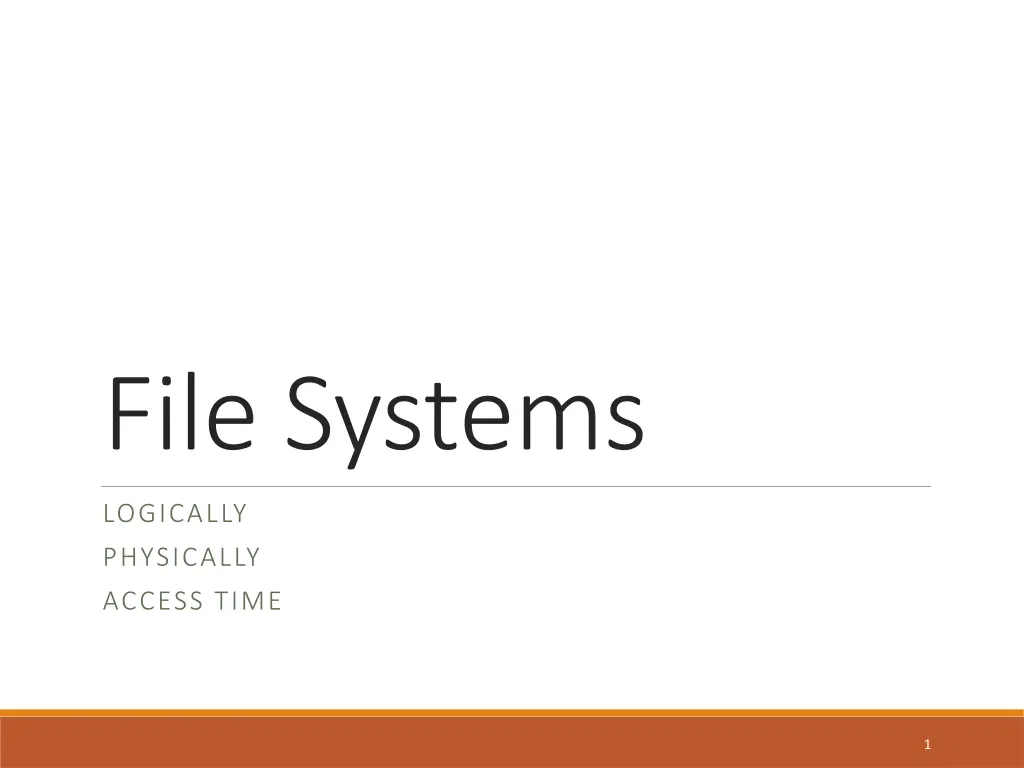
Understanding File Systems and Data Management
Explore the significance of file systems in organizing and managing data storage efficiently. Learn about file names, metadata, utilities, and access permissions associated with file systems on various storage devices.
Download Presentation

Please find below an Image/Link to download the presentation.
The content on the website is provided AS IS for your information and personal use only. It may not be sold, licensed, or shared on other websites without obtaining consent from the author. If you encounter any issues during the download, it is possible that the publisher has removed the file from their server.
You are allowed to download the files provided on this website for personal or commercial use, subject to the condition that they are used lawfully. All files are the property of their respective owners.
The content on the website is provided AS IS for your information and personal use only. It may not be sold, licensed, or shared on other websites without obtaining consent from the author.
E N D
Presentation Transcript
File Systems LOGICALLY PHYSICALLY ACCESS TIME 1
File System A file system is a means to organize data expected to be retained after a program terminates by providing procedures to store, retrieve and update data as well as manage the available space on the device(s) which contain it. A file system organizes data in an efficient manner and is tuned to the specific characteristics of the device. A tight coupling usually exists between the operating system and the file system 2
Secondary Storage File systems are used on data storage devices, such as I. hard disk drives, II. floppy disks, III. optical discs, or IV. flash memory storage devices, to maintain the physical locations of the computer files. They may provide access to data on a file server by acting as clients for a network protocol (e.g. NFS, SMB, or 9P clients), 3
File names A file name (or filename) is used to reference the storage location in the file system. Most file systems have restrictions on the length of the filename Most file system interface utilities have special characters that you cannot normally use in a filename (the file system may use these special characters to indicate a device, device type, directory prefix or file type). Some file system utilities, editors and compilers treat prefixes and suffixes in a special way. These are usually merely conventions and not implemented within the file system. 4
Metadata (data about data) Other bookkeeping information is typically associated with each file within a file system. The length of the data contained in a file may be stored as the number of blocks allocated for the file or as a byte count. The time that the file was last modified may be stored as the file's timestamp. File systems might store the file creation time, the time it was last accessed, the time the file's meta-data was changed, or the time the file was last backed up. 5
Utilities File systems include utilities to initialize, alter parameters of and remove an instance of the file system. Directory utilities create, rename and delete directory entries and alter metadata associated with a directory. File utilities create, list, copy, move and delete files, and alter metadata. They may be able to truncate data, truncate or extend space allocation, append to, move, and modify files in-place. Also in this category are utilities to free space for deleted files if the file system provides an undelete function. 6
Access and permission There are several mechanisms used by file systems to control access to data. Usually the intent is to prevent reading or modifying files by a user or group of users. Another reason is to ensure data is modified in a controlled way so access may be restricted to a specific program. Examples include passwords stored in the metadata of the file or elsewhere and file permissions in the form of permission bits, access control lists, or capabilities. 7
User Data The most important purpose of a file system is to manage user data. This includes storing, retrieving and updating data. Some file systems accept data for storage as a stream of bytes which are collected and stored in a manner efficient for the media. When a program retrieves the data it specifies the size of a memory buffer and the file system transfers data from the media to the buffer 8
Network File system A network file system is a file system that acts as a client for a remote file access protocol, providing access to files on a server. Examples of network file systems include clients for the NFS, AFS, SMB protocols. NFS I. Network File System (NFS) is a distributed file system protocol originally developed by Sun Microsystems in 1984,[1] allowing a user on a client computer to access files over a network in a manner similar to how local storage is accessed. II. NFS, like many other protocols, builds on the Open Network Computing Remote Procedure Call (ONC RPC) system. III. The Network File System is an open standard defined in RFCs, allowing anyone to implement the protocol. 9
Logical files Sequential Access - allows data to be read from a file or written to a file from beginning to end. It is not possible to read data starting in the middle of the file, nor is it possible to write data to the file starting in the middle using sequential methods. Word, PowerPoint etc. Documents are sequential The input and output streams in Java are sequential. Direct Access - permit nonsequential, or random, access to a file's contents. You can "seek" to any particular location within a file specifying the number of bytes. Database records are random access files. 10
Disk drive 11
Sectors, Tracks and Blocks Tracks rings on the disk Sectors slices of the disk Blocks part of a track from sector boundary to sector boundary. Example) Block Address Block address for track 3 sector 2 could be <3,2> 12
Linear view of disk Blocks = <track,sector> <0,0> <0,1> <0,2> <0,3> <1,0> <1,1> <1,2> 13
Directories (folders) Collections of files and Directories Attributes of a file - filename - file type(extension) (ex: Word, PowerPoint etc.) - owner ID - date created - date last modified Non-visible attributes of a file - file location on disk <track,sector> - file internal type (ex: contiguous, linked, indexed) 14
Contiguous Allocation File A IF File B IF File C IF Free Free File A can fix in 1.5 blocks File B can fit in 1.5 blocks File C can fit in 0.7 blocks IF Internal fragmentation File A IF EF EF File C IF Free Free EF External fragmentation after File B is deleted 15
Files that cant fit contiguously Suppose the disk has the following free spaces(blocks) between files. File A File C File B File D You want in insert a file that is too big to fit in any free space contiguously but small enough to fit within the total of all free spaces. What can you as the operating system, do? - defragment the disk (takes a lot of time) - scatter the file though out the free spaces 16
File Space Allocation Methods Contiguous Allocation File data is located on disk physically together. Block after block. Linked Allocation File data is located on disk in non-contiguous block locations where each block contains the address of the next block. Indexed Allocation File data is located on disk in non-contiguous block locations and there is also an index (block(s) of storage) that contains the locations of the files blocks 17
Contiguous Allocation - User must indicate the size of the file before allocating it. - Files may grow and shrink dynamically making this difficult - Directory entry contains <initial block address> , <#block> - If an N block file starts at block B, then the last block is B+N-1 - External fragmentation may occur 18
Linked Allocation - File blocks are chained into a linked list on the disk - files may grow and shrink dynamically making this difficult. - File size doesn t not need to be specified when allocating it. - Directory entry contain <initial block address> , <last block address> - If an N block file starts at block B, then the last block is B+N-1 - No external fragmentation occurs - internal fragmentation (links and last block wasted space) 20
Linked Files 21
Indexed Files - Each file has an index block that is an array of disk block addresses - The i-th entry in the index block is the i-th block of the file. - A file directory entry contains the address of the index block. - Supports sequential and direct access files without external fragmentation. - Internal fragmentation (index(s), wasted space in index blocks, wasted space last file block) - When the index is larger that 1 block, multiple index blocks could be contiguous, linked or indexed (tree). 22
If the index cant fit in a block The index is a collections of <track,sector> pairs. If the index is so big, in must span multiple blocks: - contiguous index - linear - linked index linked list - indexed index (multiple levels of indices) - tree 24
File seek time (find Track) Files stored on a round rotating disk with a moveable read/write head will take some time to access the data. The access time is modeled by: T = s + (m*n) s = startup time T = estimated seek time n = number of tracks traversed. m = constant that depends on the disk drive. For example, an inexpensive hard disk on a personal computer might be approximated by m = 0.3 ms, s = 20 ms, while more expensive disk drive might have m = 0.1 ms and s = 3ms. Rotational delay, typically disks rotate at 3600 rpm, which is 16.7 ms per rotation. Which is on average, a half a rotation is 8.35 ms. 26
File Transfer time/Total time Transfer time can be modeled as: T = b/rN T = transfer time b = number of bytes to be transferred N = number of bytes on a track r = rotation speed, in revolutions per second The total average access time can be expressed at: T = (Track seek time) + (rotational delay) + (Transfer time) 1 2 1 ? ? 1 = (s + (m*n)) + ? + ? 27
Seek Time algorithms FCFS (First-Come-First-Serve) There is no reordering of the queue. SSTF (Shortest-Seek-Time-First) Disk arm is positioned next at the request (inward or outward) that minimizes arm movement SCAN Disk arm sweeps back and forth across the disk surface, serving all requests in its path. It changes direction only when there are no more requests to service in the current direction. C-SCAN (Circular-SCAN) Disk arm moves unidirectional across the disk surface toward the inner track. When there are no more requests for service ahead of the arm, it jumps back to surface the request nearest the outer track and proceeds inward again. N-Step scan Disk arm sweeps back and forth as in SCAN, but all requests that arrive during a sweep in one direction are batched and reordered for optimal service during the return sweep. 28
File Type: Direct Access Records are directly (randomly) access by their physical address on the direct access storage device (DASD). The application user places the records on the DASD in any order appropriate for a particular application. Hashing techniques are often locating data in a Direct access file. Direct Access Files exploit the capability found on disks to access directly any block of a known address. A key field is required in each record. There is no order to the records. 29
Record Blocking (Direct) Fixed Blocking Fixed length records are used, and an integral number of records are stored in a block. There may be unused space at the end of each block. Variable-length spanned blocking Variable-length records are used, and are packed into blocks with no unused space. Thus, some records must span two blocks, with the continuation indicated by a pointer to the successor block. Variable-length unspanned blocking Variable-length records are used, but spanning is not employed. There is wasted space in most blocks because of the inability to use the remainder of the block if the next records is larger that the remaining unused space. 30
Access Methods Queued Access Used when the sequence in which records are to be processed can be anticipated, such as in sequential and indexed sequential accessing. The queued methods perform anticipated buffering and scheduling of I/O operations. They try to have the next record available for processing as soon as the previous one is processed. Basic Access Used when the sequence in which records are to be processed cannot be anticipated. 31
RAID (Redundant Array of Inexpensive Redundant Array of Inexpensive Disks) Disks) 32

